NOTE: This article was published first by me on Quora.com on Jul 21, 2011. Last updated was in Dec 2014.
As it happens with the IT industry where a lots of jobs gets outsourced, the same happens – to some degree – with the movie industry as well.
Movies, especially those with a lighter budget and not so known stars, are increasingly being produced abroad (reducing the costs).
Besides Canada (Vancouver) and UK (London) looks like Romania (Bucharest) is another destination for Hollywood for making movies (Bulgaria seem to make a dent too).
There are over 100 film companies in Romania, big and small. Some have their own infrastructure (the biggest), some are renting the infrastructure from others.
It depends also on what genre the movies belong, but the biggest studios can pretty much handle every genre.
I will present the biggest and then I will redirect you to a website which shows all those film productions companies (I don’t know how updated is that database though).
I will make an introduction about filmmaking in Romania below then after that I’ll give more details about film studios from Romania.
*****************************
Some A but mostly B movies were shot in Romania in the last 20 years and here you have some examples:
- Cold Mountain (A movie)
- The Zero Theorem (A movie)
- The Necessary Death of Charlie Countryman (A movie)
- Ghost Rider: Spirit of Vengeance (A movie)
- Youth Without Youth (A movie)
- Modigliani (A movie)
- The Concert (A movie – European)
- Adam Resurrected (A movie)
- Amen (A movie – European)
- Callas Forever (A movie – European)
- The Brothers Bloom (A movie)
- Dying of the Light (A movie)
- Closer to the Moon (A movie – European)
- The Whistleblower (A movie – European)
- Hatfields & McCoys (mini-series)
- One In The Chamber (B movie)
- Beowulf (B movie)
- BloodRayne (B movie)
- The Cave (B movie)
- Borat (the first) (B movie)
- Fire & Ice: The Dragon Chronicles (B movie)
- Born To Raise Hell (B movie)
- 7 Seconds (B movie)
- Them (B movie – European)
- Highlander: EndGame (B movie)
- Transylmania (B movie)
- Anaconda 3 and Anaconda 4 (B Movies)
- Second in Command (B movie)
- The Detonator (B movie)
- Seed of Chucky (B movie)
- Shadown Man (B movie)
- Method (B movie)
- Hellraiser Deader and Hellraiser Hellworld (B movies)
- Diplomatic Siege (B movie)
- Caved In (B movie)
- Perkins 14 (B movie)
- Timber Falls (B movie)
- Transylmania (B movie)
- And many others…
By looking at these you will see that most of the movies are B movies with movie stars which once were A (or never were A) but now their time have mostly gone (Jean Claude Van Damme, Steven Seagal, Dolph Lundgren, Cuba Gooding Jr, Tara Reid, Christopher Lambert, Wesley Snipes, Elizabeth Hurley and so on).
The biggest, in terms of budget, movie made in Romania is still Cold Mountain with about $80 millions (main actors were Jude Law, Nicole Kidman, Renee Zellweger – directed by Anthony Minghella).
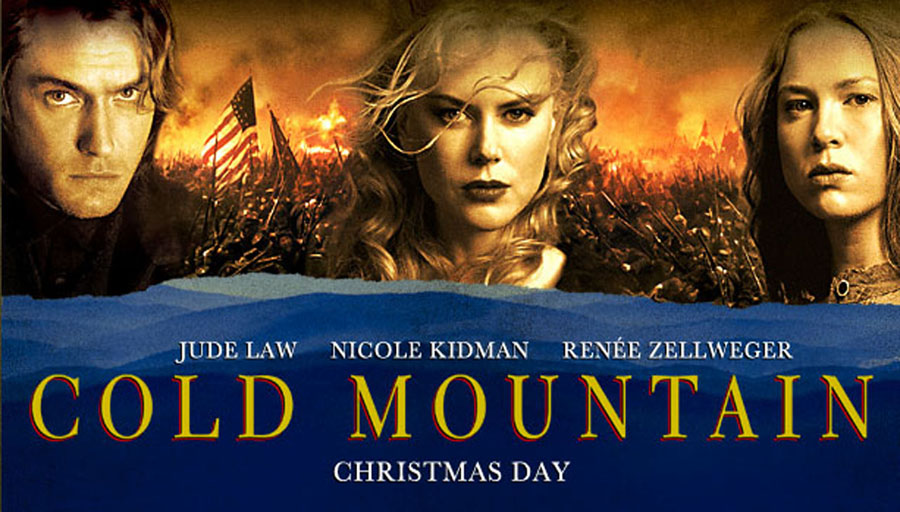
The second one is Ghost Rider: Spirit of Vengeance with $75 millions (main actors are Nicholas Cage, Idris Elba, Christopher Lambert – directed by Mark Neveldine and Brian Taylor).
The rest of the movies are low to medium budget, in the action or horror genres (mostly).
Romania has a tradition in making movies, the first film made was The Independence of Romania (1912), before D.W.Griffith made his The Birth of a Nation.
See here more about the history of moviemaking in Romania.
Romania gave Hollywood a well known director at that time: Jean Negulesco.
He was an A director, having well-known stars in his movies: Marilyn Monroe, Barbara Stanwyck, Lauren Bacall, Robert Wagner, Peter Lorre, John Garfield, Joan Crawford, Jane Wyman, Alec Guiness, Clifton Webb, Fred Astaire).
Romania also gave Hollywood a known actor of its time, the former five times Olympic swimming champion Johnny Weissmuller (who can forget his Tarzan movies?).
Petru Popescu is another Romanian-American screenwriter-director in Hollywood.
In the ’70 there was a case when a well known Romanian director at that time was very close to make an historical movie about a period of Romania history but having Hollywood actors as the main cast (Charlton Heston, Orson Welles, Richard Burton, Elizabeth Taylor, Kirk Douglas).
The movie is Michael The Brave but because of the communist dictator at that time it was made with Romanian actors instead. Even so, the movie was one of the best historical movies made then (the director in case being Sergiu Nicolaescu ).
There are some other actors in Hollywood which have Romanian origins: Sebastian Stan (“Captain America” – born in Romania) , Edward G. Robinson (many movies – born in Romania), Lauren Bacall (many movies – born in USA from Romanian mother), Adrian Zmed (“T.J. Hooker series” – born in USA from Romanian parents), Harvey Keitel (many movies – born in USA from a Romanian mother), Natalie Portman (many movies – born in USA and her paternal grandmother was Romanian), Dustin Hoffman (many movies – born in USA and has a Romanian parent), Wynona Ryder (many movies – born in USA and part of her father’s family comes from Romania), Brian Unger (“The Daily Show” – born in USA from a Romanian mother).
Nowadays, the Romanian new generation of filmmakers have gone to win the international recognition once again culminating with winning the Palme d’Or at Cannes for the movie 4 Months, 3 Weeks and 2 Days by Cristian Mungiu (and again with Beyond the Hills), Megatron by Marian Crisan (Palme d’Or at Cannes for short films), Child’s Pose by Calin Peter Netzer (Golden Bear at Berlin Film Festival), If I Want to Whistle, I Whistle by Florin Serban (Silver Bear at Berlin Film Festival).
(See more acclaimed movies in the last 20 years here Romania: What are some of the best Romanian movies? )
*****************************
Today there are eight main production houses in Romania (the first 3-4 getting the bulk of the business) and I will present all of them below (with contact details).
CASTEL FILM
One of the biggest seem to be Castel Film www.castelfilm.ro (they seem to have most of the foreign movies made in Romania).
Here is their portfolio: http://www.castelfilm.ro/movies
Castel Film one of the largest private film production company from Romania (the first private company if its kind, formed in 1992) and one of the largest in Central and Eastern Europe.
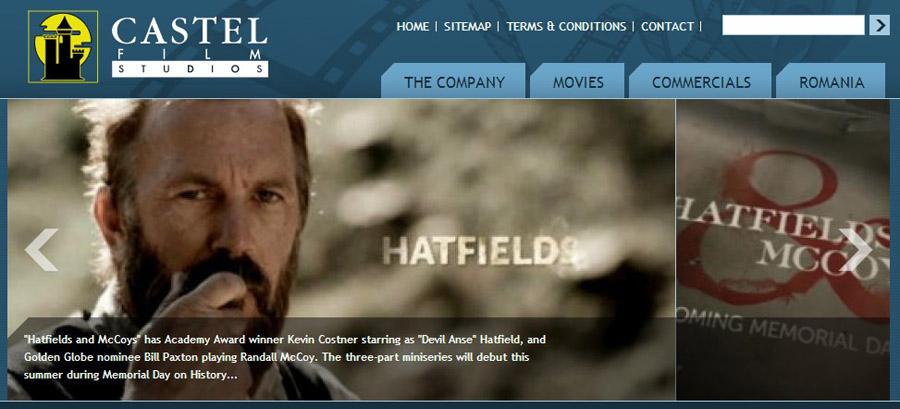
Their partners are: Paramount, Miramax, Focus Features, Sony Pictures, Beacon, HBO, Dimension Films, ABC Network, Section Eight, USA Network, Kushner-Locke, Trimark Pictures, Full Moon Entertainment (USA), Granada Media, BOX TV (UK), Esqwad, JLA Production, Les Productions du Tresor, Raphael Films, Noe Productions
They have:
– 9 Modern fully equipped Soundstages – each stage with separate facilities;
– one of the largest soundstage in Continental Europe: 3250 square meters, a 37 hectares backlot including 15 hectares of forest, available for set construction;
– direct access to a large lake – with a 1000 meters waterfront
They don’t shoot just movies but also commercials and music videos.
The location is 20 minutes by car from the Henri Coanda International Airport (near capital Bucharest).
Contact details
Office
Tel: +40-212 225 565
Fax: +40-212 225 559
E-mail: office@castelfilm.ro
Address: Bucharest, 25A, Emanoil Porumbaru ST., Sector 1
Vlad Paunescu – Owner and CEO
Tel: +40-212 225 565
Fax: +40-212 225 559
E-mail: vlad.paunescu@castelfilm.ro
Cristi Bostanescu – Head of Film Production
Tel: +40-212 225 565; / Fax: +40-212 225 559
Mobile: +40-723 212 023
E-mail: cristi.bostanescu@castelfilm.ro
Bogdan Moncea – Marketing Director
Tel: +40-212 225 565
Fax: +40-212 225 559
Mobile: +40-723 230 737
E-mail: bogdan.moncea@castelfilm.ro
Penny Karlin – The Karlin Connection – US Representative
23480 Park Sorrento, Suite 117A Calabasas – CA 91302
Tel: +1-818 224 3888
Fax: +1-818 224 3869
E-mail: pkarlin@thekarlinconnection.com
See on IMDB movies produced by Castel Film: http://www.imdb.com/company/co0020879/
MEDIAPRO STUDIOS
MediaPro www.mediaprostudios.com is also one of the biggest private filmmaking company from Romania. It’s part of the MediaPro Group, the largest media consortium in Romania (which has also foreign investors).
It was formed in 1998 when the private media company MediaPro bought the state owned studios Buftea. Buftea studios were established in 1957 and produced over 500 films during this time rivaling any Western European film studio at that time.
Many of their productions seem to be Romanian but they have also international productions like Amen (Costa Gavras), Callas Forever (Franco Zefirelli), Modigliani (Mick Davis), BloodRayne (Uwe Boll).
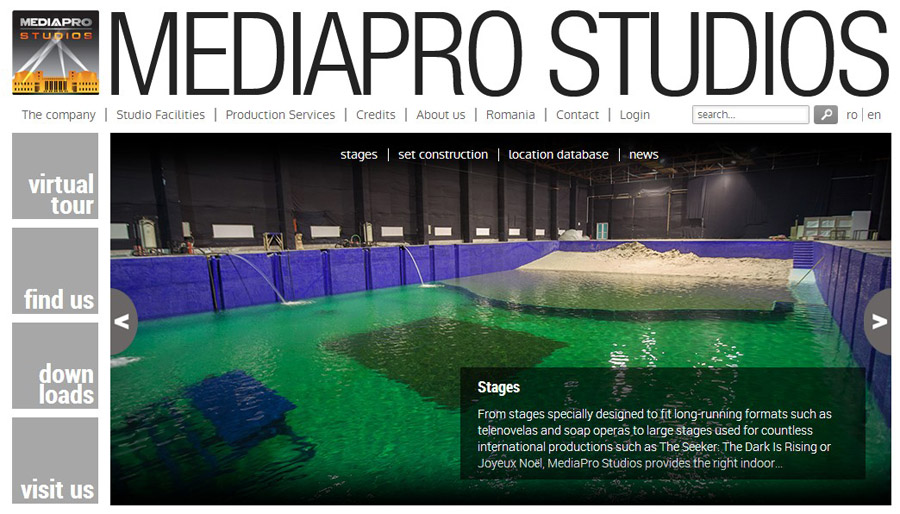
See their portfolio here: http://www.mediaprostudios.com/credits
MediaPro Studios currently boasts 19 soundstages (including one chroma stage), 4 water tanks, one screening room and a 100-acre backlot.
The stages have varying sizes, from 2,020 to 44,900 sq. ft., with heights ranging from 16 to 50 ft. They are fully equipped for film and TV productions.
Contact details
Office
Phone: +4 031 82 51 801/815
Fax: +4 031 82 51 839
Address: 1 Studioului Street, 070000 Buftea, Ilfov, ROMANIA
E-mail: office@mediaprostudios.ro
International Sales
Phone: +4 031 82 51 303
Fax: +4 031 82 51 839
E-mail: sales@mediaprostudios.com
Local Sales
Phone: +4 031 82 51 227
Fax: +4 031 82 51 891
E-mail: vanzari@mediaprostudios.ro
They have also an in-house VFX studio.
See on IMDB movies produced by MediaPro Studios.
KENTAUROS STUDIOS
(new partnership with Solar Entertainment Group of Bobby Paunescu and became Solar Studios)
Kentauros www.kentauros.ro is one of the newest entrants in the market (established by foreign film people and investors) and was formed in 2003 being a challenger for the studios above.
The studios are brand new using, mostly, the newest technology available on the market. Recently it was bought by the real estate businessman Dragos Savulescu.
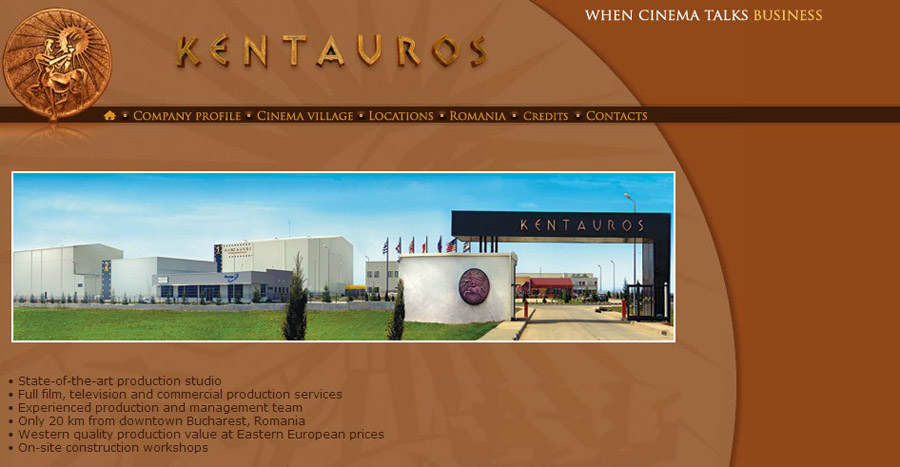
They have 6 soundstages, on-site set construction (wood, metal, plaster, molding, very large format printing).
Their portfolio isn’t as rich as the others, for now having only two features made: http://www.kentauros.ro/html/features.php
Contact details
Office
Adress: 57 Stefanesti Street, Ilfov District
Stefanestii de Jos, 077175, Romania
Tel: +40 372 119 000
Fax: +40 372 119 001
E-mail: office@kentauros.ro
See on IMDB movies produced by Kentauros: http://www.imdb.com/company/co0289020/ and http://www.imdb.com/company/co0216438/
MANDRAGORA MOVIES
Mandragora International Group www.mandragoramovies.com was founded in 2004 and exhibited a highly dynamic evolution since its creation, covering activities like the development, production and distribution of films, studios rental and other related services. Currently the group has subsidiaries in Bucharest, Paris and New York.
Mandragora Movies is one of the most dynamic movie production companies from Romania, founded by Bobby Paunescu in 2005, with the aim to produce not only feature films but also television projects.
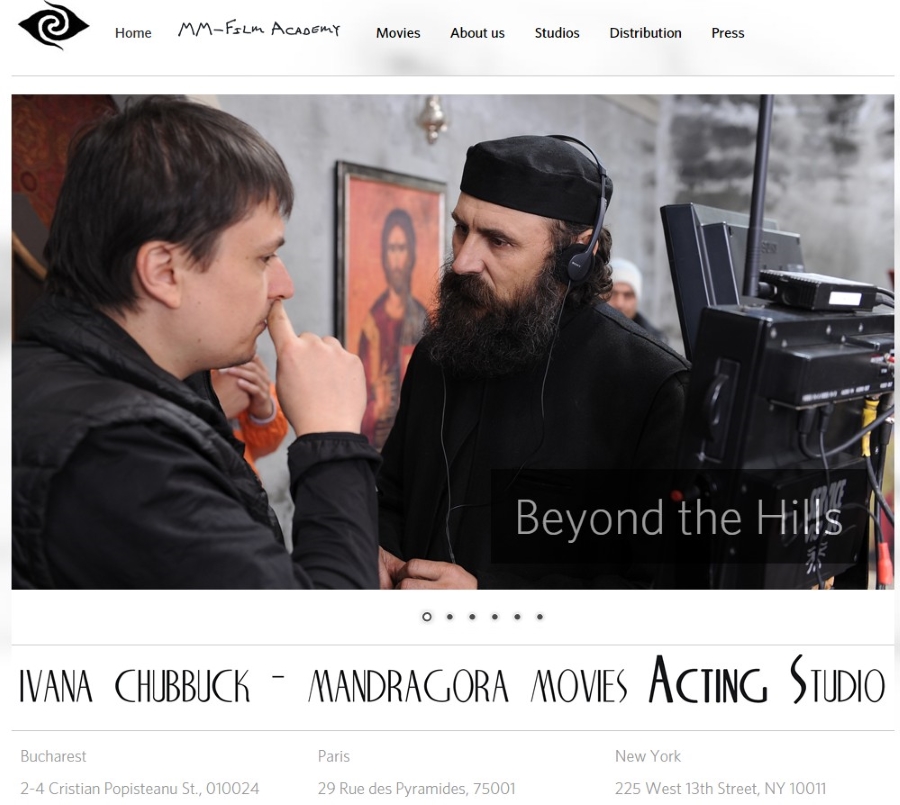
This studio includes:
– 3,000 sqm wooden panels of green screen;
– A 250m long street, with building facades constructed on both sides at a height of 11m;
– A small square with a functional interior set (30sqm) and a position convenient for a bus station;
– A larger square with the building of another interior set (70sqm);
– Functional street lighting at a height of 9m;
– Functional illuminated shop signs which can easily be adapted;
– Sidewalks
The second studio is an exterior period set from the ‘60s, with a surface of 5,000sqm. The construction includes a large square with green space – trees, bench, and statue; a small street with full height buildings facades. The studio also includes two functional interiors of 40sqm and 60sqm.
See on IMDB movies produced by Mandragora movies: http://www.imdb.com/company/co0149931
Contact details
Bucharest
2-4 Cristian Popisteanu St., 010024
bucharest@mandragoramovies.com
Paris
29 Rue des Pyramides, 75001
paris@mandragoramovies.com
New York
225 West 13th Street, NY 10011
newyork@mandragoramovies.com
ATLANTIS FILM
It was also established in 1992 (like Castel Film), having also its own facilities www.atlantisfilm.ro.
It’s quite close to the city center (Bucharest) – about 10-20 min.
Regarding film production, it seems that this production house worked mostly at French movies.
See here their portfolio: http://www.atlantisfilm.ro/filmography.htm
Contact details
Office
Address: 6, Balota str. , sect 1 , Bucharest, Romania
Tel: +40 216 671 815
+40 317 104 027
fax: +40 317 104 026
e-mail: studio@atlantisfilm.ro
Ion Marinescu (French): +40 744 542 225
Madalina Marinescu (English): +40 723 345 022
See on IMDB the movies produced by Atlantis Film: http://www.imdb.com/company/co0020612/
DOMINO FILM
Domino Film www.dominofilm.ro is a smaller studio which had several local and European films, TV and documentaries produced.
See here the local productions: http://dominofilm.ro/production.html
And here some European productions they helped: http://dominofilm.ro/services.html

Contact details
Office
Address: 59, Dr. Felix Street, 011039 Bucharest 1, Romania
Phone: +40 21 317 6436
+40 21 317 6422
Fax: +40 21 312 9609
E-mail: office@dominofilm.ro
Cristian Comeaga – producer
phone: +40 722 200 509
e-mail: cristi@dominofilm.ro
See on IMDB the movies produced by Domino: http://www.imdb.com/company/co0256376/
LIBRA FILM PRODUCTIONS
This company www.librafilm.net is also a smaller film production house which worked at some local and European films. It was established in 1994.
Here is its portfolio: http://www.imdb.com/company/co0166497/
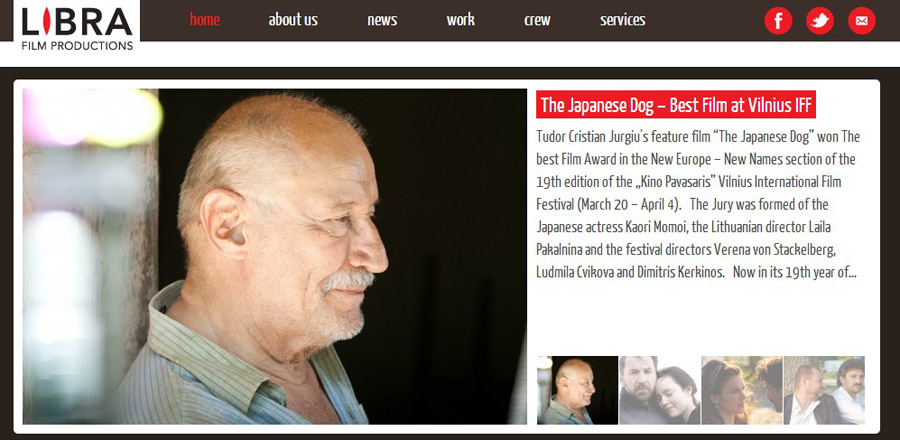
Contact details
Office
Address: 52 Popa Soare Str., Et.1, Ap.4 Sector 2, Bucharest, Romania
Phone: +40 213 266 480
Fax: +40 213 260 268
E-Mail: office@librafilm.net
See on IMDB movies produced by Libra Film: http://www.imdb.com/company/co0160572/
STRADA FILM
Strada Film www.stradafilm.ro is also a small production company having several local films under its belt.
See their portfolio: http://www.stradafilm.ro/films/?lang=1
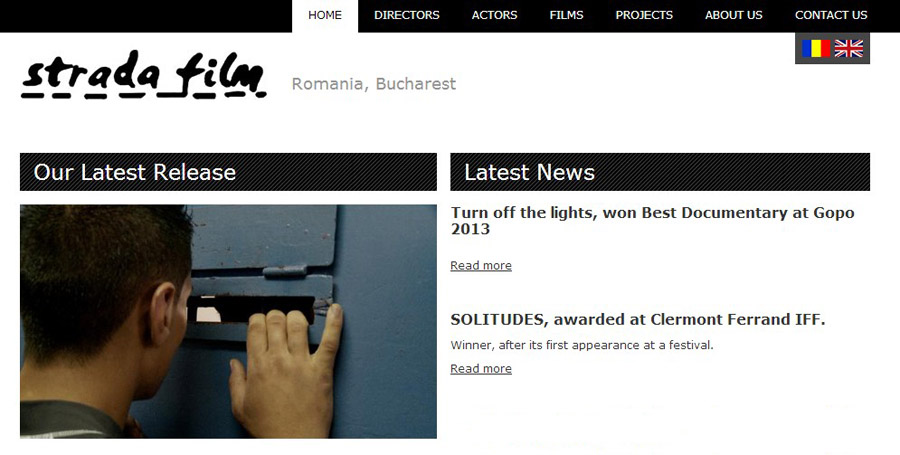
Contact details
Office
Address: Dr. Staicovici 41, sector 5, 050556, Bucharest, Romania
Tel/fax: +40 214 118 099
Email: contact@stradafilm.ro
Daniel Mitulescu
Producer
daniel@stradafilm.ro
Marcian Lazar
Producer
marcian.lazar@stradafilm.ro
Bianca Oana
Head of Development
bianca@stradafilm.ro
See on IMDB the movies produced by Strada Film: http://www.imdb.com/company/co0160572/
*****************************
A special mention here….
If you are shooting on film then there is a well known lab there with which productions houses above are working with.
The company is Cinelabs www.cinelab.ro
They offer not only film related services but also digital related.
Contacts details
Manager
Phone: +40 740 032 222
E-mail: cornelia.popa@cinelab.ro
Customer Service
Phone: +40 740 035 555
E-mail: sales@cinelab.ro
Beside the production houses above there are many other smaller companies.
A list can be seen here: http://www.cinematograph.ro/ro/bazadedate/case-de-productie-film or here http://www.kftv.com/country/Romania (but remember, not all of them can produce a feature film)
If you are looking for dedicated visual special effects (for film) production houses then here are what I found to have the best portfolio.
MediaPro Magic (it’s part of MediaPro Group which also owns MediaPro Studios)
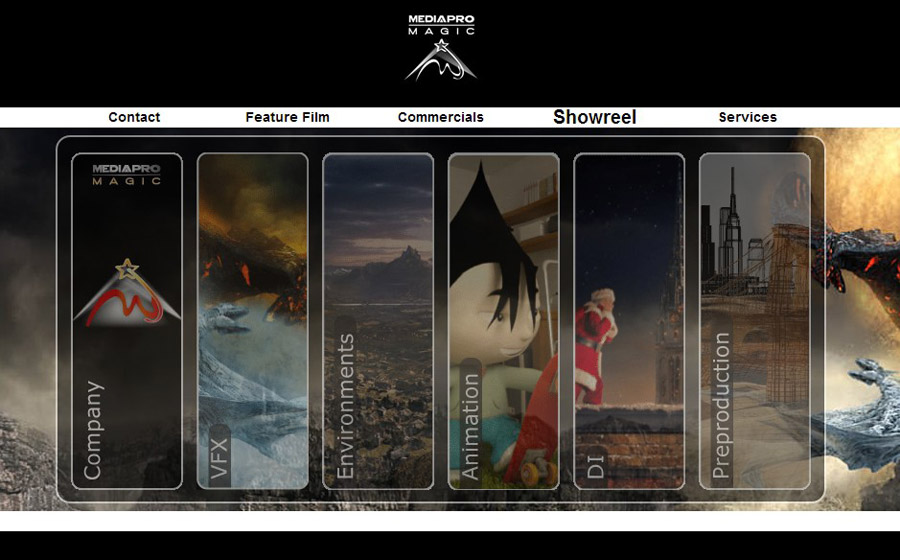
MediaPro Studios is the only studio complex in Central and Eastern Europe to have an in-house special effects department. The team is coordinated by Adrian Popescu and supervised by Nick Allder, Academy Award winner for Alien and a BAFTA award for The Fifth Element.
Umbrella VFX www.umbrellavfx.com
Umbrella VFX has been at the forefront of post-production in Central and Eastern Europe. The company’s artists have pioneered the use of CG on the regional television market and since inception, they have worked on corporate and non-profit projects alike. The company development strategy opened new directions for its activity in 2007 and currently Umbrella is present in three countries located on two continents.
Contact details
GENERAL CONTACT
Phone / Fax: +40.314.328.736
Email: office@umbrellavfx.com
BUCHAREST, Romania
Email: bucharest@umbrellavfx.com
Address: 319th Calarasilor Ave. PoBOX:030622
CAIRO, Egypt
Email: cairo@umbrellavfx.com
Address: 13th Khopho Street PoBOX:11511
BRESCIA, Italy
Email: brescia@umbrellavfx.com
Address: 14th Via Civerchi PoBOX:25036
Abis Studio www.abisstudio.ro
Contact details
Phone: +4021 222 68 75
Fax: +4021 223 44 93
office@abisstudio.ro
Unfortunately, Romanian officials are not involved much in filmmaking.
There is a national authority named “Centrul National al Cinematografiei” (the National Center for Cinema) http://cnc.gov.ro but other than organizing screenwriting contests (and awarding some state money for the winners – those scripts has to involve Romania somehow) they don’t seem to do much.
Contact details
http://cnc.gov.ro (sorry, no English version)
Office
Address: Str. Dem. I. Dobrescu nr. 4-6, Sector 1, Bucharest, 010026
Tel: +40 213 104 301
Fax: +40 213 104 300
E-mail: contact@cnc.gov.ro
It doesn’t seem that Romania have laws to encourage film productions, especially co-productions (Romanian+foreign – if they are related to Romania then it may be possible to get some state financing).
There is no a “rebate law” (tax incentives), like you find in some US states or Canada. Maybe this will change soon but there is no date when. But because the work is cheaper there that compensates the lack of these incentives.
Hope these information will help you and any other filmmaker who wants to do movies in Romania.
You can contact me if you want to find out more.




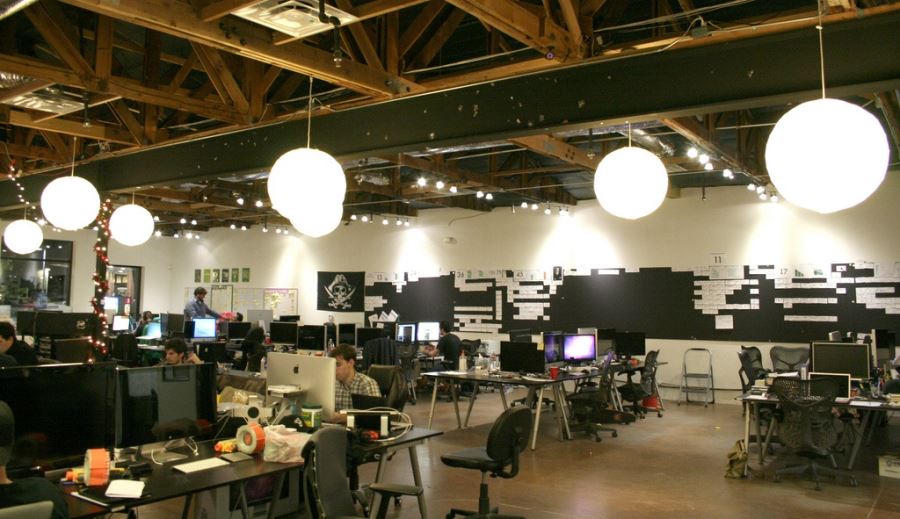

 I was always watching movies since childhood. I even kept a list of movies I saw until it became too big.
I was always watching movies since childhood. I even kept a list of movies I saw until it became too big.

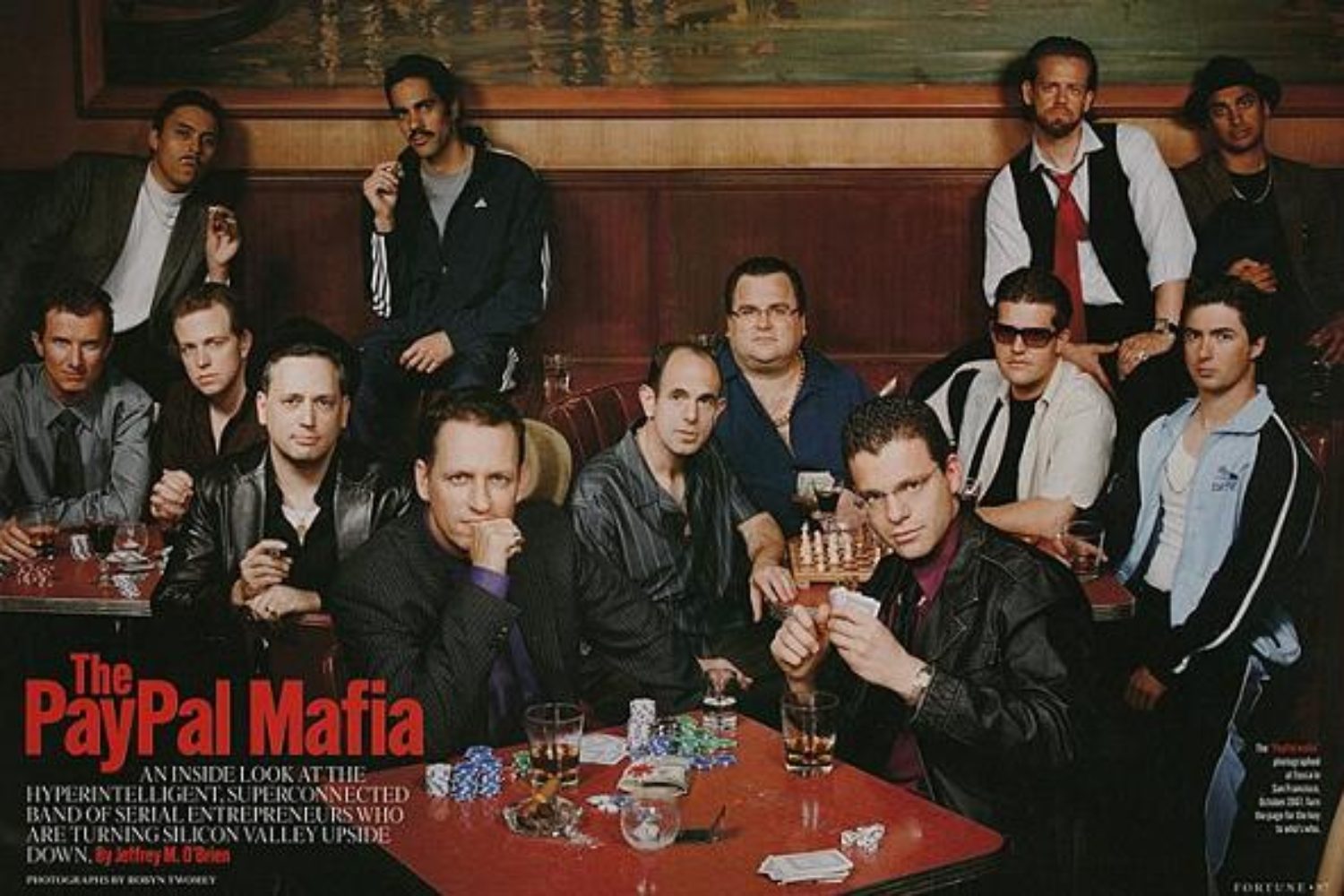
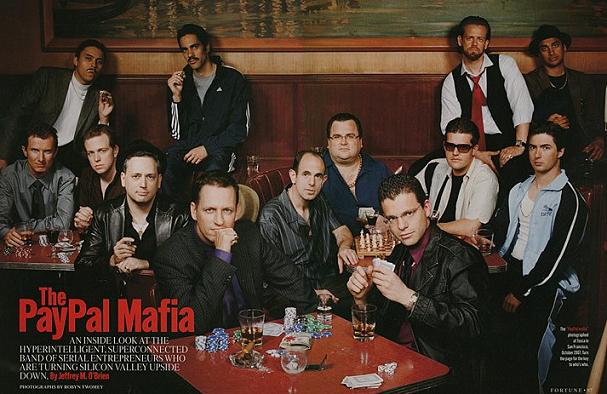



 In searching for a tech co-founder you also need to be aware of what you are bringing to the table, beside the idea.
In searching for a tech co-founder you also need to be aware of what you are bringing to the table, beside the idea.
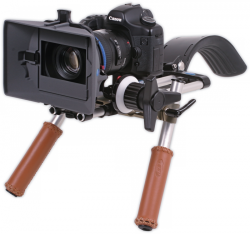



 Quora.com, the “continually improving collection of questions and answers created, edited, and organized by everyone who uses it” where I joined sometime ago has also a quite strong filmmaking community (screenwriters, directors, actors, crew), besides an entrepreneurship community.
Quora.com, the “continually improving collection of questions and answers created, edited, and organized by everyone who uses it” where I joined sometime ago has also a quite strong filmmaking community (screenwriters, directors, actors, crew), besides an entrepreneurship community.